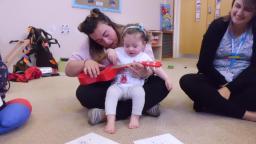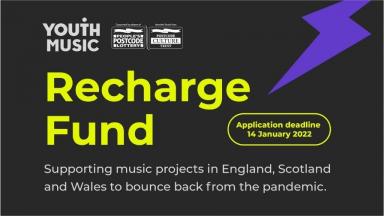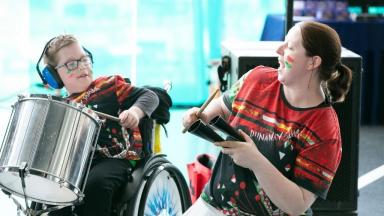Improving the wellbeing of staff, freelancers, volunteers, and young people means embedding wellbeing in your day-to-day working practices. But what does that actually mean? In this article we share some real examples from two organisations and consider ways you could measure improvements in your practices.
A big concern from respondents to our COVID-19 research last year was burnout and the deteriorating mental health of staff and volunteers. The Youth Music Recharge Fund has been designed to address this, providing funding for organisations to improve their wellbeing practices. Improving wellbeing is not a luxury. It is essential for a happy and healthy workplace. It supports staff retention, motivation and productivity. Ultimately, it improves the impact of your work.
Most adults spend one-third of their time at work. So, transforming workplace mental health will have knock-on effects in how wider society deals with mental health now and in the future.

WILD Young Parents' Project
Wild Young Parents has taken several measures to support their staff and community wellbeing since the onset of the pandemic, when they saw rising levels of mental health needs. They invested in a dedicated mental health support role, to guide and support staff who might be dealing with young people with complex mental health issues. All delivery staff can now receive external supervision.
After lockdown, Wild Young Parents invested in equipment - including laptops, ergonomic workstation equipment and headphones - to improve home working. They also created new roles to ease the pressure on staff. They evaluated their working practices and now offer a home working scheme. “We increased the range of flexible working hours available, and gave a percentage of designated paid family leave each day for caring responsibilities.”
Youth Music
Mental health and wellbeing were recurring themes in our 2020 staff survey. In response, we organised Mental Health First Aid training for all of our staff. This improved our understanding of mental health and began to normalise conversations around it. The training covers prevention, early intervention and signposting to support. Given the subject matter, some of us did find the topics triggering. That said, many of us have gone on to use the advice in our day-to-day lives, so the impact has gone way beyond our workplace.
Our annual staff survey is anonymous. It provides an essential forum for staff to raise concerns and for us to monitor how we are doing. There are a standard set of questions covering areas of structure and capacity, benefits, culture, management, teamwork and relationships with colleagues. This allows us to see where we have made progress, and where we need to improve. Areas of job satisfaction and wellbeing include specific questions about salary satisfaction, team capacity, stress, work/life balance and how we can improve wellbeing in the workplace.
The staff survey is great for annual tracking and strategic planning, but we also want to meet individual needs on an ongoing basis. We’ve tried to create an open, honest and caring culture whereby people look out for each other and can come to work as their authentic selves. But we also ensure that wellbeing is an ongoing conversation (for example in our supervision framework) and have services available through a virtual GP, mental health support and wellbeing package that all staff have access to.
We’ve tried a few wellbeing-related activities including gong baths, yoga and singing workshops. More recently, our staff Values Committee has launched a wellbeing fund, where employees can make an application for a wellbeing-related activity that benefits all staff or shows gratitude to an individual.
How should we measure progress?
Evaluation is an important element of learning and development. But when you’re thinking about tracking change, keep your plans simple. Try and work with data you already have. Only introduce new forms of data collection if they have long-term value beyond the scope of the grant.
Getting the views of staff, freelancers, and volunteers will be vital in demonstrating progress in your organisational wellbeing practices. In terms of specifics, the 2019 report from Britain’s Healthiest Workplace covers a wide number of areas related to wellbeing. Investors in People also run a specific We Invest in Wellbeing accreditation with a wellbeing framework that is free to download.
Still not sure?
We hope these examples sparks some ideas. However, the best ideas are likely to come from your team and peers. Speak to them to help you plan and prioritise.
Are there other helpful resources available?
- If you are D/deaf or Disabled and need support to make an application, you can apply for up to £900 via our Access Fund. Click here to find out how to apply for access funding.
- In our experience, good planning makes a compelling application. We’ve put together a list of additional resources and websites to help you further think through your proposal.
- Finally, we have developed a simple management accounts template for organisations that don’t already have one.
You may also like...
Recharge Fund
The Youth Music Recharge Fund offers grants of up to £90k (max £30k per year) to boost organisations in their post-covid recovery.
Improving capacity and capability
Do you need inspiration for your Youth Music Recharge Fund proposal? Our project community have shared some recent examples of how they’ve improved capacity and capability. We’ve added our own experiences to these, alongside some ideas about how you might measure progress.
Wellbeing, capacity and capability resources
Take a look at more resources that can support you with well-being, capability and capacity.




